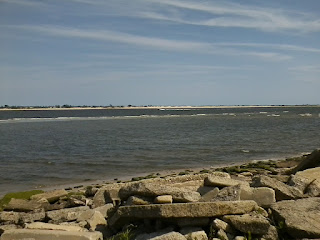Today I rode to Point Lookout again. It was not a perfect day, by most people’s
definitions, but more than good enough for me:
clouds moved across a sunny sky, seemingly carried by the wind that I
rode into on my way out to the Rockaways.
The temperature didn’t seem to rise above 25C anywhere I rode—the ocean
water was only a couple of degrees cooler.
That might be the reason why I didn’t see very many people on the
beaches or boardwalks, and the Point, like Jones Beach, across the cove, was
deserted.
The ride made me happy, even if it didn’t include
any great developments or epiphanies. I
felt as if I got into a good rhythm while riding Arielle, my fixed-gear
Mercian. Most important of all, I didn’t
feel achy or fatigued at the end of my ride:
I just felt as if I’d gotten a good workout and had a good time. I really don’t ask for anything else.
Probably the most unusual things about this ride
happened at two traffic stops—one in Atlantic Beach on my way out and the other
in Sunnyside on my way back.
At the first stop, the light had just turned
red. I had about another half an
hour—maybe forty minutes, given that I was riding into the wind—of riding to
get to the Point. Not that I was in a
hurry: I wasn’t worried about any
commitments or even about the coming of night.
But I had, as I mentioned earlier, gotten into a good rhythm, and was
trying not to stop.
The light had just turned red and a man who looked
like he had a decade or two on me was crossing the street. Some guy in a Lexus tore through the
intersection, against the red light.
Fortunately, the old man hadn’t gotten very far into the street, so he
was in no danger of being struck.
What I found strange about the encounter, though,
was the man kept on staring at me. I
wasn’t sure of whether he was surprised that I, and not the driver, stopped for
the light. Or, perhaps he’d been directing stored-up anger over other cyclists
who’d ignored traffic signals—or, maybe just stories he’d heard about
them. Whatever his motivations, he kept
his head turned toward me until he stepped onto the curb on the other side of
the street.
At the other stop, I was about two kilometers from
my apartment. Sunnyside is, like
Astoria, an old blue collar-to-middle class neighborhood that never really deteriorated
and is becoming home to increasing numbers of young professionals and creative people
who work in Manhattan. It’s also one of
those neighborhoods where, at one time, I wouldn’t see anyone else on a bike
but, over the past few years, I have been seeing more and more cyclists every
time I ride through it.
Anyway, I stopped at an intersection of 48th
Steet, one of the neighborhood’s main arteries.
Trucks often come barreling down 48th, coming from or going
to the factories and rail yard that separate the neighborhood from Long Island
City, so I don’t take chances when crossing it.
Neither do most people who live in the neighborhood.
A woman who looked like she was thirty, at most,
crossed in front of me, with her son and daughter—neither of whom looked more
than four years old—in tow. She seemed
like a nice person; we exchanged smiles.
“I’m sorry,” she simpered.
“For what?”
“For stopping you.”
“You didn’t stop me. The light did.” I pointed to the signal; it was turning
yellow. She and her kids scampered to the curb.
“Have a nice day,” she shouted.
“You do the same.”
As pleasant as she was, I am still as puzzled by
her reaction to my stopping for a light as I am to the man for his.
| Photo by Darryl Kotyk |






